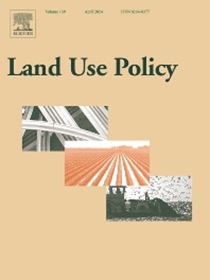Potential of peatlands restoration for GHG emissions mitigation in France: Investigation of acquisition costs
IF 6
1区 社会学
Q1 ENVIRONMENTAL STUDIES
引用次数: 0
Abstract
Public demand for the restoration of degraded French peatlands is strong, as they contribute to climate change. A French carbon offset accreditation is being developed to facilitate private investment in peatland restoration. Assessing the costs of restoration programs and projects is vital to target cost-efficiency. Studies on acquisition costs are non-existent in the peatland scientific literature, while the sale price of peatlands could increase restoration costs, hampering the feasibility of operation works. Given the need for spatially explicit information for restoration planning, we use the first stage of the hedonic prices method to provide a model that measures the price of French peatlands and its determinants, at a national scale. Real peatland sales from the DVF+ database (Cerema) are exploited. The parcels selected in the model are distributed along a gradient of elevation, state of degradation and intensity of land use. Predictions of peatland prices are then made in the Cotentin-Bessin and jurassian massif regions to check the validity of the model. The average peatland price is 3014 €/ha but it varies greatly between regions. The main results indicate that intensive land use (crops) and increasing slope raise the selling price, while elevation, increasing distance to settlement and moor land use lower it. The prediction results are encouraging for a nationwide use of peatland prices in restoration planning programs. This study will also help get a better understanding of implications of peatland acquisition in restoration and total costs. This study provides ex-ante information before the price of land may rise due to soaring carbon prices and the attractiveness of peatland purchase for private sector following the implementation of the French carbon offset accreditation for peatlands. Afterwards, the focus should be put onto complementary land indicators such as fragmentation. The methods developed in the article can be applied to other contexts where there are overlapping land uses.
求助全文
约1分钟内获得全文
求助全文
来源期刊

Land Use Policy
ENVIRONMENTAL STUDIES-
CiteScore
13.70
自引率
8.50%
发文量
553
期刊介绍:
Land Use Policy is an international and interdisciplinary journal concerned with the social, economic, political, legal, physical and planning aspects of urban and rural land use.
Land Use Policy examines issues in geography, agriculture, forestry, irrigation, environmental conservation, housing, urban development and transport in both developed and developing countries through major refereed articles and shorter viewpoint pieces.
 求助内容:
求助内容: 应助结果提醒方式:
应助结果提醒方式:


